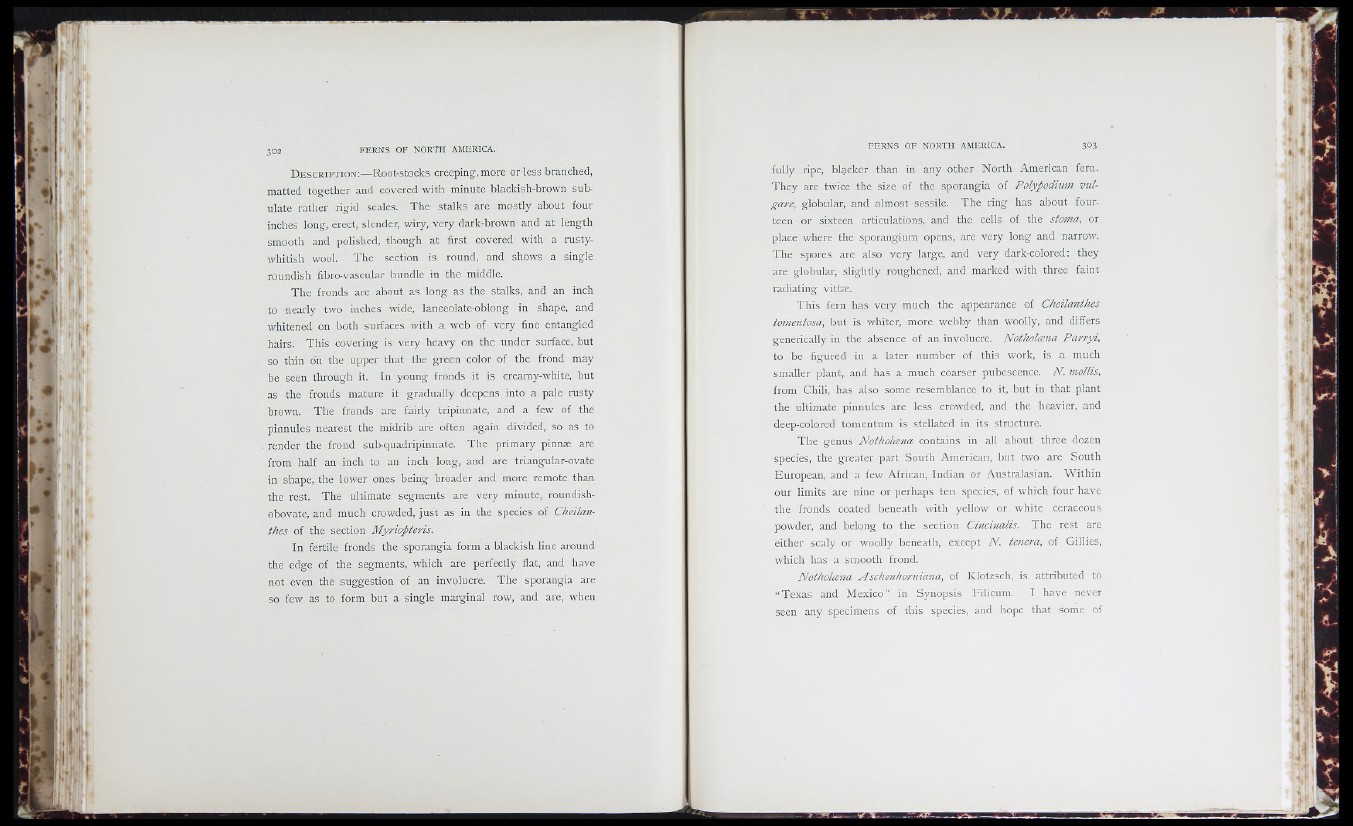
• 1
i
i *
» 1
r
• t
\ "
H»*'
M 1
I k J i
tec É '
1 '
J
. *
t '
I» «k
i f ' *
li
i /
b
I '
M r
302 F E R N S O F N O R TH AMERICA.
D e s c r i p t i o n :—Root-stocks creeping, more or less branched,
matted together and covered with minute blackish-brown subulate
rather rigid scales. The stalks are mostly about four
inches long, erect, slender, wiry, very dark-brown and at length
smooth and polished, though at first covered with a rusty-
whitish wool. The section is round, and shows a single
roundish fibro-vascular bundle in the middle.
The fronds are about as long as the stalks, and an inch
to nearly two inches wide, lanceolate-oblong in shape, and
whitened on both surfaces with a web of very fine entangled
hairs. This covering is very heavy on the under surface, but
so thin on the upper that the green color of the frond may
be seen through it. In young fronds it is creamy-white, but
as the fronds mature it gradually deepens into a pale rusty
brown. The fronds are fairly tripinnate, and a few of the
pinnules nearest the midrib are often again divided, so as to
render the frond sub-quadripinnate. The primary pinnæ are
from half an inch to an inch long, and are triangular-ovate
in shape, the lower ones being broader and more remote than
the rest. The ultimate segments are very minute, roundish-
obovate, and much crowded, just as in the species of Cheilanthes
of the section Myriopteris.
In fertile fronds the sporangia form a blackish line around
the edge of the segments, which are perfectly flat, and have
not even the suggestion of an involucre. The sporangia arc
so few as to form but a single marginal row, and are, when
F E R N S O F N O R TH AM ER ICA . 3 0 3
fully ripe, blacker than in any other North American fern.
They are twice the size of the sporangia of Polypodium vulgare,
globular, and almost sessile. The ring has about fourteen
or sixteen articulations, and the cells of the stoma, or
place where the sporangium opens, are very long and narrow.
The spores are also very large, and very dark-colorcd : they
are globular, slightly roughened, and marked with three faint
radiating vittæ.
This fern has very much the appearance of Cheilanthes
tomentosa, but is whiter, more webby than woolly, and differs
generically in the absence of an involucre. Notholcena Parryi,
to be figured in a later number of this work, is a much
smaller plant, and has a much coarser pubescence. N. mollis,
from Chili, has also some resemblance to it, but in that plant
the ultimate pinnules are less crowded, and the heavier, and
deep-colored tomentum is stellated in its structure.
The genus Notholcena contains in all about three dozen
species, the greater part South American, but two are South
European, and a few African, Indian or Australasian. Within
our limits are nine or perhaps ten species, of which four have
the fronds coated beneath with yellow or white ceraceous
powder, and belong to the section Cincinalis. The rest are
either scaly or woolly beneath, except N. tenera, of Gillies,
which has a smooth frond.
Notholcena Aschenhorniana, of Klotzsch, is attributed to
“ Texas and Mexico” in Synopsis Filicum. I have never
seen any specimens of this species, and hope that some of
• M